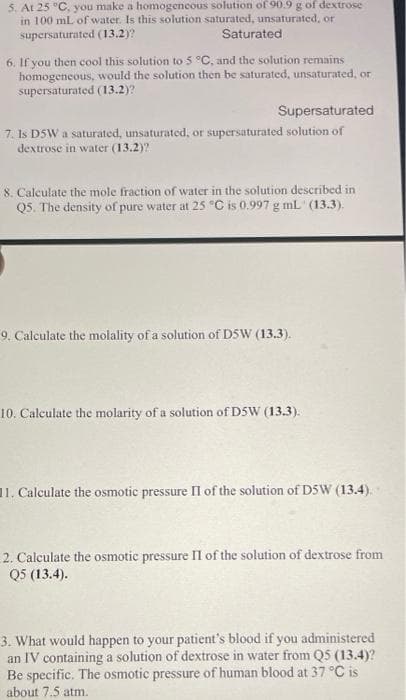8. Calculate the mole fraction of water in the solution described in Q5. The density of pure water at 25 "C is 0.997 g mL ' (13.3). 9. Calculate the molality of a solution of DSW (13.3). 10. Calculate the molarity of a solution of D5W (13.3).
8. Calculate the mole fraction of water in the solution described in Q5. The density of pure water at 25 "C is 0.997 g mL ' (13.3). 9. Calculate the molality of a solution of DSW (13.3). 10. Calculate the molarity of a solution of D5W (13.3).
Chemistry: Principles and Reactions
8th Edition
ISBN:9781305079373
Author:William L. Masterton, Cecile N. Hurley
Publisher:William L. Masterton, Cecile N. Hurley
Chapter10: Solutions
Section: Chapter Questions
Problem 6QAP
Related questions
Question

Transcribed Image Text:5. At 25 "C, you make a homogeneous solution of 90.9 g of dextrose
in 100 mL of water. Is this solution saturated, unsaturated, or
supersaturated (13.2)?
Saturated
6. If you then cool this solution to 5 °C, and the solution remains
homogeneous, would the solution then be saturated, unsaturated, or
supersaturated (13.2)?
Supersaturated
7. Is DSW a saturated, unsaturated, or supersaturated solution of
dextrose in water (13.2)?
8. Calculate the mole fraction of water in the solution described in
Q5. The density of pure water at 25 °C is 0.997 g mL (13.3).
9. Calculate the molality of a solution of DSW (13.3).
10. Calculate the molarity of a solution of D5W (13.3).
11. Calculate the osmotic pressure Il of the solution of D5W (13.4).
2. Calculate the osmotic pressure II of the solution of dextrose from
Q5 (13.4).
3. What would happen to your patient's blood if you administered
an IV containing a solution of dextrose in water from Q5 (13.4)?
Be specific. The osmotic pressure of human blood at 37 °C is
about 7.5 atm.
Expert Solution
This question has been solved!
Explore an expertly crafted, step-by-step solution for a thorough understanding of key concepts.
This is a popular solution!
Trending now
This is a popular solution!
Step by step
Solved in 2 steps with 1 images

Knowledge Booster
Learn more about
Need a deep-dive on the concept behind this application? Look no further. Learn more about this topic, chemistry and related others by exploring similar questions and additional content below.Recommended textbooks for you

Chemistry: Principles and Reactions
Chemistry
ISBN:
9781305079373
Author:
William L. Masterton, Cecile N. Hurley
Publisher:
Cengage Learning

Chemistry & Chemical Reactivity
Chemistry
ISBN:
9781133949640
Author:
John C. Kotz, Paul M. Treichel, John Townsend, David Treichel
Publisher:
Cengage Learning

Chemistry & Chemical Reactivity
Chemistry
ISBN:
9781337399074
Author:
John C. Kotz, Paul M. Treichel, John Townsend, David Treichel
Publisher:
Cengage Learning

Chemistry: Principles and Reactions
Chemistry
ISBN:
9781305079373
Author:
William L. Masterton, Cecile N. Hurley
Publisher:
Cengage Learning

Chemistry & Chemical Reactivity
Chemistry
ISBN:
9781133949640
Author:
John C. Kotz, Paul M. Treichel, John Townsend, David Treichel
Publisher:
Cengage Learning

Chemistry & Chemical Reactivity
Chemistry
ISBN:
9781337399074
Author:
John C. Kotz, Paul M. Treichel, John Townsend, David Treichel
Publisher:
Cengage Learning